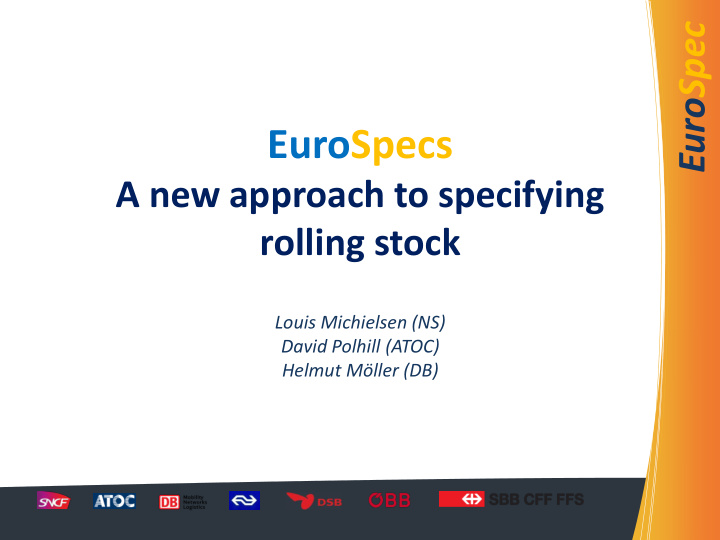



EuroSpec EuroSpecs A new approach to specifying rolling stock Louis Michielsen (NS) David Polhill (ATOC) Helmut Möller (DB)
EuroSpec Situation in Europe at Euro Spec’s start Market: Legislative environment ▪ ▪ Manufacturers are heading for TSI framework almost complete; ▪ standard adaptable platforms; Decreasing amount of add on ▪ TOCs tender their procurement; national regulation; ▪ ▪ TOCs no longer design and specify Cross acceptance being RST. implemented. Opportunity: define a common base and eliminate differences in non-competitive domain Potential: ▪ Change to develop a real European platform; ▪ Promotion of interoperability and cross functional homologation; ▪ Economics of scale and standardisation reduce cost and improve quality and reliability.
EuroSpec EuroSpec ‘s idea: to create a base specification for principle rolling stock functions among operators 3
EuroSpec EuroSpec ’s goal: to improve quality and reliability of trains EuroSpec • …Started in 2011 as a partnership of several European train operating companies (TOCs) acting as partners; ▪ …provide common technical specifications based on the experience of all partners; ▪ …can be used in train procurement instead of company specific requirements; ▪ …are company, manufacturer and product neutral, describing functions of rolling stock and their verification. 4
EuroSpec Results already achieved by EuroSpec Specified and published specification modules ▪ Toilets; ▪ Air conditioning; results ▪ Requirements management; ▪ Documentation. Application and dissemination of EuroSpec documents: ▪ Discussion with manufacturers; ▪ Already used in tenders ; ▪ Publication at www.eurospec.eu. 5
EuroSpec EuroSpec ”Requirement management” The document EuroSpec Requirements Management provides a common focus on ▪ Eurospec “requirements management” “requirements management” for use by has defined a common reference and companies in the rail sector. The document refers to existing standards and best practices and has method for the other working groups, to the following chapters as content: improve standardisation between all • Requirements Characteristics; • Requirements Syntax; working groups; • Requirements Attributes; • Requirements Traceability; • Requirements Validation and Verification; ▪ Eurospec “requirements management” • Requirements Interchange Format; trains and coaches the specialists in • Do we mean standards? writing requirements; ▪ Eurospec “requirements management” reviews and improves the EuroSpecs on several quality aspects.
EuroSpec EuroSpec ”Documentation” begins with common reference for rolling stock analogous as in other sectors The EuroSpec on Documentation provides : • A common reference to be used for tendering and verification; • In future releases additional specifications on structure and standardisation of content, format and exchange of the documents; • It is finally intended to facilitate the exchange of technical documentation within the railway sector in a harmonised way.
EuroSpec Current and future work Currently EuroSpec experts are working on: ▪ Technical documentation for rolling stock (content, structure and format); ▪ Requirement management (verification methods and interchangability of req.) ▪ Mechanical parts of automatic couplers; ▪ Moveable step; ▪ Pantograph strip; ▪ Wheel and brake disc. Future work: ▪ Open discussion with manufacturers; ▪ Feedback loop from use in tenders; ▪ New identified topics. 8
EuroSpec Outlook ▪ TOC’s have shown to be able to reduce their own specific requirements by making use of the first EuroSpec’s ; ▪ For powerful railway sector further standardisation is needed: ▪ Increase of reliability by sharing good practice and experience; ▪ Simplification of tender process in time and effort; ▪ Standardised products and increase cost efficiency. ▪ EuroSpec fills a gap in current standardisation landscape; ▪ Eurospec is a mean to obtain mature products needed to offer excellent products to the end customers. 9
EuroSpec Interested in joining, using, suggesting? Have a look at www.eurospec.eu
Recommend
More recommend